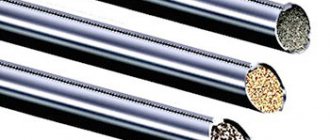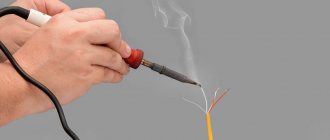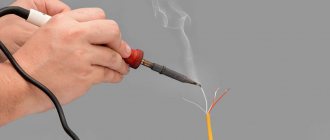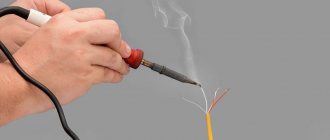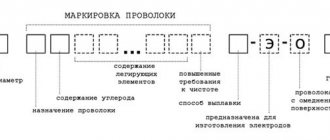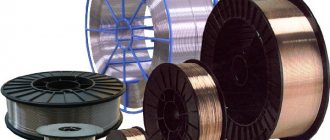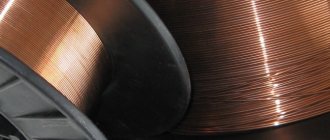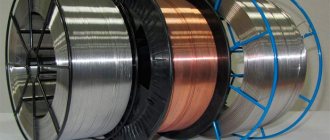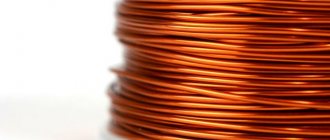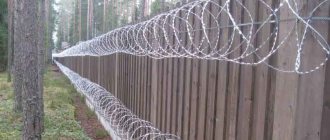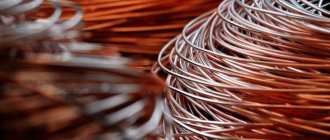In the modern world, there is not a single industrial enterprise that does not use electric arc welding in its production activities. Thanks to this factor, the domestic market for semi-automatic devices is constantly growing and actively developing.
Today it is represented by a wide range of technical means, specific devices and consumables, the most popular of which is welding wire for semi-automatic machines. This important component must match its characteristics as closely as possible to the properties of the metal from which the parts being connected are made. Therefore, a large number of filler products have been developed that are most suitable for a certain type of work.
Types of wire
Welding wire is an indispensable element for successful work operations in various industries and utilities. With its help, several metal segments are connected into a solid structure.
The features of this filler material include ease of use and excellent quality of work performed. Proper selection of wire not only improves the reliability of the weld, but also significantly increases productivity.
Wire for semi-automatic machines is usually supplied in coils, coils and coils. The weight of the first type of packaging sometimes reaches 1.3 tons. The weight of the second type of container can vary from 15 to 120 kilograms. The mass indicators of the third form of packaging range from 5 to 18 kilograms.
Often the wire is placed in boxes or plastic bags. If the product does not have packaging, then before use the wire is dried at a temperature of 200°C.
Powder
This wire is a hollow object made of metal, the free space of which is filled with powder and flux.
These materials help protect the seam from exposure to oxygen and harmful substances formed during the welding process. An important factor here is also ensuring the safety of the respiratory system of the specialist performing technological work.
The use of special additives in welding wire facilitates ignition of the arc and helps reduce metal spattering, which has the most favorable effect on the formation of a high-quality seam. The arc burns in a flux medium, which allows you to protect the area of the welded area from the negative influence of the environment.
For work using flux-cored wire, heavy gas cylinders are not required, which are associated with many hassles: storage, refilling and possible leakage.
Copper-plated
Copper-plated wire is a product designed to work with carbon and low-carbon steels. It is coated with a special copper compound and is used for welding objects in a protective gas environment.
The best manufacturers
Today, even the most picky buyer knows which company’s product is best to buy. In our case, the “Name” of the manufacturer is also of great importance. Moreover, there are quite a lot of manufacturers on the modern market and this somewhat complicates the choice. We are only interested in quality products, so we will get to know the best manufacturers from different countries.
Russia
Leopard
Filler materials of this brand have been produced by Barsweld since 2008. In terms of the characteristics of the final product, they will compete with any European manufacturer. The company's assortment includes various types of consumables, including: stainless, aluminum, copper, copper-plated, powder. Modern equipment from Europe ensures high final quality of the product.
CHZSM
In 2012, the production of filler rods began at the Cherepovets Welding Materials Plant. Today it is one of the leaders among domestic manufacturers, equipped with the most modern equipment and highly qualified personnel. The range of brands and diameters is quite wide.
Svarmontazhstroy (SMS)
Russian company from Dolgoprudny in the Moscow region. Produces solid wire at world standards. The product is in high demand among shipbuilders, mechanical engineering enterprises and engine manufacturers, energy complex enterprises, etc. The quality control and management system is based on compliance with the provisions of the international standard ISO 9001:2015. There are two options in the range: copper-plated and Ultra (without coating, with improved surface characteristics).
Sudislavsky Welding Materials Plant
Production is launched in the Sudislavsky district of the Kostroma region. The main activity is the production of electrodes. In 2011, the plant commissioned a technological line for the production of two types of wire:
- copper-plated, polished with graphite coating, with a diameter from 0.8 to 1.6 mm for work in a gas environment;
- copper-plated for different grades of steel, with a diameter from 2.0 to 5.0 mm, for welding with flux.
The company's products are in high demand
China
Rods made in China are in high demand due to their decent quality and budget price. There are a significant number of Chinese manufacturers on the market. Let's get to know some of them.
DEKA
The company produces and supplies the market with inexpensive and high-quality welding consumables of its own production. Her product is intended for semi-automatic and argon devices.
Farina
The company is engaged in the production of wire for joining parts made of low-alloy and carbon steels. The material is in demand in various industries. The consumable from Farina is characterized by its low cost, stable thickness, and fast ignition of the arc. To preserve the working qualities of the goods during long-term transportation, sealed packaging is used.
Sweden
ESAB
The world leader in the production of welding materials is of Swedish origin. Its products are in high demand among welders around the world. The range of brands is extremely wide. Polished wire from ESAB is in particular demand. The company owns more than two dozen factories in Europe, Asia, and America.
Elga
Swedish company. On the market since 1938. The range includes all types of filler materials. The company's products are used mainly for the assembly of critical structures. The plant's equipment is the most modern. There is a research center and laboratory where new technical solutions are developed.
Italy
Quattro Element
The manufacturer is known for reliable and high-quality products and a wide range of products, including stainless, flux-cored, aluminum and copper-plated filler rods. According to welders, some of them are the best in the world.
Novofil SRL
The company is rightfully considered one of the world leaders in the production of wire for working with low-alloy, low-carbon aluminum products. Copper and bronze coated materials are produced. The product quality is consistently high.
USA
Lincoln Electric
Products for semi-automatic welding from this American company guarantee a stable arc and high productivity. They are in high demand among craftsmen all over the world.
Hobart Brothers
Solid, powder and aluminum filler rods from the American company Hobart Brothers are in high demand. The promotion of their products on the world market is carried out exclusively by company managers in sales offices around the world.
Marking
The basic requirements regulating all issues of production of wire for welding work are presented by GOST 2246-70 . Today, about 80 varieties of this type of product are manufactured. And in order to understand what a particular type of product is, it is assigned a certain label, which helps to understand the composition of the product and its characteristics. A good example is the popular welding wire sv08g2s .
Its decoding is represented by the following values:
- The combination of the letters “st” indicates that this product refers to welding wire;
- The combination of numbers “08” indicates the amount of carbon (in hundredths) contained in the product;
- The letter “g” emphasizes the presence of manganese in the wire;
- The number “2” is the volume of manganese in the element;
- The letter “c” indicates the presence of silicon in the wire, but if there is no number after the letter designation, this means that the product contains less than 1%, but more than 0.5%.
Based on the markings stated above, we can say that the presented product is an alloyed low-carbon wire, which contains additives such as silicon and manganese.
Types of wire for welding, its classification
Different types of materials are used as welding mixture. They are made of aluminum, brass, steel, stainless steel, and metal alloy. Products may be coated with copper (copper-plated wire). All “consumables” must have certificates and be manufactured in accordance with GOST 2246. There are several types of products used in MIG welding:
- Solid section (solid) are used most often, in part due to their lower cost. The selection criteria for one type or another depends on the base metal and its thickness. The thin mild steel does not produce slag and the cord cools quickly.
- Flux-cored wire behaves like conventional electrodes. It consists of a metal shell, a hollow internal space filled with granular powder (flux). During repair or construction, this mixture introduces alloying elements into the weld. They leave slag behind and as a result cooling occurs slowly, which is an advantage when working with thick materials.
- The activated model is similar in composition to the powder model, but has fewer granular additives (5-7% of the total mass), and is used for welding in CO2 and its mixtures.
Products are sold in drums of different diameters 0.8 / 1.0 / 1.2 / 1.6 mm. According to welders, it is better to buy copper-coated wire; it protects against oxidation, facilitates electrical contact of the welding machine nozzle with the surface being welded, reducing friction.
There are many classifications for each type depending on its composition, the shielding gas used and the application. Let's look at this information in more detail. First, let's study international standards, then domestic brands:
1. The solid cord must be similar in composition to the base metal, the mixture containing varying amounts of deoxidizing agents, depending on the application and shielding gas.
The most common additive is silicon; it contains a small amount of various metals that improve the mechanical properties of welding equipment and corrosion resistance. These wires oxidize better and are generally more suitable for CO2 work as they prevent the formation of pores.
Carbon steel wire is listed by the American Society (AWS) under the designation “ER 70 S – x” (Imperial Unit), where: “E” is the electrode; "R" - filler; 70 is the minimum tensile strength expressed in thousands of pounds per square inch (psi); "S" - hardness; "x" is a number representing information about the chemical composition of the electrode ("2", "3", "4", "6" or "7"), it corresponds to a variable amount of carbon, manganese and silicon in addition to a fixed mass of phosphorus, sulfur, nickel, chromium, molybdenum, copper and other elements. Let's consider the properties of products in accordance with the last digit:
- The ER70S-2 provides good welding in C-25 gas (75% argon + 25% CO2) even on oxidized steel. Of the entire series, this is the only brand that contains titanium, zirconium and aluminum. Its main disadvantage is its lack of fluidity, it is reluctant to move to the side and does not adhere properly to heavy materials.
- ER70S-3 is one of the most common and budget “MIG” models; it is less viscous. The product is successfully used in cars, agricultural and household appliances.
- ER70S-4 has an average cost and is suitable for almost all types of steel welding. ER70S-4 has good fluidity, better arc characteristics than E70S-3, but has more spatter, used in welding structural steels, boats, pipes and boiler rooms.
- ER70S-6, ER70S-7 have the best functions and the highest cost, they contain a lot of silicon, manganese as deoxidizers. They work with any grade of steel, from fine carbon to 1/2-inch thick sheets. Suitable for any commonly used gas mixtures, good fluidity. The products are used in the production of car bodies, furniture, fire extinguishers, high-pressure vessels and pipes.
These cords can be used for welding stainless steel. However, for better corrosion resistance, you should pay attention to stainless steel wire, one of the most common options is “304”, “ER308”, with an increased silicone content in the types “ER308L” and “ER308LS”. Areas of application for these wires: chemical and food equipment, tanks for corrosive chemicals, pumps, heat exchangers.
Products made of non-ferrous metals are used to work with aluminum. There are many similar wires, including:
- ER-1100, ER-4043 are used with argon, helium, and other industrial gas mixtures, ideal for working with thick sheets and castings. The main industries using this type are food, dairy and refrigeration.
- ER-5356 contains 5% magnesium, this wire will work in most situations. Its high tensile strength makes it suitable for the manufacture and repair of rolled fuel tanks.
It is impossible to provide universal advice: “Which product is better to buy?” The popularity of models depends on the specific work situation.
2. Flux-cored electrodes (“FCAW” welding) are carbon, low-alloy, stainless steel and cast iron. They are classified according to the mechanical properties of the deposited metal.
The marking, based on the imperial system, is as follows: “E 7 1 T - 1 C / M”, where: E – electrode; 7 is the minimum tensile strength of the deposited metal, expressed in thousands of pounds per square inch; 1 - welding position (can be “0” or “1”). “0”—flat and horizontal position; "1" denotes all positions; T - tubular (1 indicates correct use of the electrode in terms of polarity and general performance, ranges from "1" to "14" or from "G" to "GS".
"G" indicates that polarity and general performance characteristics are not specified. The letter "S" after the "G" means that the cord is suitable for one pass only); C/M - Shielding gas required. “C” - 100% CO2, “M” - a mixture of argon and CO2. If there is no letter, then the flux-cored wire is used for welding without gas.
The advantages of MIG powder cord include low spatter loss, easy slag removal and high resistance to impact, extreme temperatures and cracking. These wires are used in heavy industry, mining and shipbuilding.
Below we provide a comparative table of domestic brands, according to GOST:
The diameter of the wire
Wire for semi-automatic devices comes in the following diameters:
- 0.6 mm;
- 0.8 mm;
- 1.0 mm;
- 1.2 mm;
- 1.6 mm.
Such dimensional indicators allow us to fully satisfy the needs of professional welders. For highly specialized purposes, products with a diameter from 3.0 to 6.0 millimeters are perfect.
The required wire size is selected in accordance with the characteristics of the welding current and the thickness of the elements being connected.
Requirements for welding wire
The correct wire is the key to a reliable welded connection. When purchasing materials, pay attention to the following parameters:
Welding of metal structuresFeatures of cold rolled sheets - production technology, features, dimensions, properties and markings
Technical features of hot-rolled sheet - classification, manufacturing method, application options and processing features
The main characteristic of welding wire is its chemical composition. It should be as close as possible to what is present in the metal being welded. The less sulfur and phosphorus in the wire, the better the connection.
The wire must be clean; no traces of dirt or oil are allowed on its surface. Otherwise, it is better to degrease the material in solvents.
The melting point of the electrode must be lower than that of the base metal. In this case, the melting should be uniform. This will help avoid seam defects and reduce sagging and unevenness.
Popular brands
The most popular brands of welding wire presented on the domestic market are:
- Sv-08GSMT. This type of product belongs to copper materials and is used in welding operations using automatic and semi-automatic machines. The wire works well with carbon metals and alloys that contain a low percentage of alloying components. It is characterized by a high level of resistance to tensile loads. This parameter is in the range of 1000-1300 MPa. This grade of wire is widely used for joining thin-walled parts operating under high pressure. Welding is carried out in an environment of protective gases (argon and carbon dioxide);
- Sv-06Х19Н9Т. This grade of wire is intended for working with stainless steel in a protective gas environment. Thanks to the content of elements such as chromium, manganese and nickel, it has good corrosion resistance. Used in the production of food industry products;
- PP2DS. This is a representative of cored wire. This brand allows operations to be carried out in strong winds, which gas shielded welding cannot do. The wire is intended for connecting parts made of steel (carbon and low-alloy), cast iron and non-ferrous metals. Used in shipbuilding and oil industry;
- OK Autrod 19.40 . This wire is from a foreign manufacturer ESAB. It is used for working with rolled aluminum bronzes and for surfacing anti-corrosion layers on metal parts. Its yield strength is 175 MPa, and its strength reaches 400 MPa. Welding operations are carried out in pure argon. This product is used in the chemical industry and automotive industry.
Powder
Many experienced welders, when asked which welding wire is better, answer – flux-cored wire. If all previous welding materials had a solid cross-section, then this one is a tube with a powder filler.
As the powder evaporates, it works like flux - it protects the weld pool from contact with the atmosphere. Therefore, the consumable is sometimes called self-protective - there is no need for gas cylinders.
Depending on the composition of the charge, fluorite, rutile, carbonate-fluorite and other varieties are distinguished. Factors that limit the mass use of flux-cored wire are high price, impossibility of use at the slightest deformation, and careful cleaning of the fused edges.
Principle of operation
The operation of the unit is based on the principle of creating an electric arc. Heat generation is directed:
- for heating metal blanks;
- melting of metal at the junction of parts;
- melting of the metal base of the electrode.
Electric current is applied through the wire, forming a welding arc between the workpiece and the electrode. The electric arc has increased resistance relative to the metal of the wire. Hence, most of the heat flux is generated in the arc plasma.
The use of a flexible thin electrode allows:
- reduce the effect of splashing liquid metal;
- increase the size of the weld pool (penetration depth);
- make connections of thin-sheet materials (for example, cold-rolled steel sheet);
- weld stainless steels, non-ferrous metals (aluminum, copper).
Choice for semi-automatic welding
To find out which wire is best for a semi-automatic machine, you need to know that this type of welding work is considered universal and can easily cope with parts of various thicknesses; non-ferrous and ferrous metals are welded with the same quality.
A similar selection of additives is made for a specific type. The main thing is the chemical composition, which is recognized from the marking of the wire , for example, SV08G2S; an experienced performer will immediately determine for which metal such solder should be used. Only wire is used that is manufactured in accordance with GOST requirements, has a quality certificate and original packaging, which protects against mechanical damage.
Common mistakes
An error in the settings of the semi-automatic welding machine is indicated by a distinct crackling sound. Loud clicks indicate that the solder feed rate is low. It is necessary to increase the feed speed until the cracking noise disappears.
Heavy spattering of metal is often observed. This is due to an insufficient amount of insulating gas in the weld pool area. It is necessary to increase the gas supply and adjust the semi-automatic gearbox.
There are lacks of penetration or burns in the seam. This is due to the arc voltage being too low or too high and can be adjusted by setting the voltage or inductance.
https://youtube.com/watch?v=0Vpch6NF0Ew
The uneven width of the weld bead is associated with the speed of movement of the torch and its position relative to the seam, that is, it is associated with the welder’s working technique.
If you follow the manufacturer's recommendations and understand the processes occurring in the weld pool, the methods for adjusting them can be performed quite complexly at home.
What models to pay attention to
Models are presented in two types:
- rectifier;
- inverter
Rectifier
It consists of a power transformer and a block of diodes that generate a unidirectional pulsating current. Equipped with a wire feed mechanism. They work in several modes:
- MIG/MAG - solid wire is used.
- Activated wire is used - a composite material made from a layer of protective flux, base metal and alloying additives.
- A powder electrode is a hollow tubular structure with flux inside.
- Spot resistance welding (for professional models).
Most of the models produced belong to the semi- and professional class. Wire welders used in everyday life or small workshops have:
- power up to 10 kW;
- maximum welding current up to 250 A;
- open circuit voltage 15-45 V;
- weighing 25-35 kg.
Model SPECIAL MAG-172. Semi-automatic, used for welding in the “with/without gas” mode. Connects ferrous and stainless steel, non-ferrous metals (aluminium, copper) and alloys based on them.
Model ENKOR-140 MIG 56731. Device for working with low-carbon or stainless steel. Used with inert or active gas. It is possible to use a powder flexible electrode.
| Characteristics | SPEC MAG-172 | ENKOR-140 MIG 56731 |
| Power | up to 6.3 kWt | up to 5.5 kWt |
| Current | up to 250 A | up to 140 A |
| PV at maximum mode | no more than 10% | no more than 10% |
| Assembled weight | up to 35.5 kg | up to 28 kg |
Inverter
The source of arc creation is an inverter. Consists of primary and secondary rectifiers, high-frequency transformer, control unit. Settings are automated. They are small in size and have the following functions:
- Manual arc welding with all electrodes.
- Connecting parts using inert or active gas with automatic supply of a flexible electrode.
- Use of powder electrode or activated wire.
- Non-consumable electrode operation with or without gas.
Models of all classes are produced: household, semi- and professional. Convenient for beginner welders. This is explained:
- ease of use;
- stable electric arc characteristics;
- resistance to changes in voltage parameters in a stationary power supply network.
Model Resanta SAIPA 135. Semi-automatic device used for joining workpieces made of ferrous and stainless steels, non-ferrous metals. It is used for welding with and without gas, as well as with flux-cored wire.
Model Svarog REAL MIG 200. Semi-automatic for working in MMA, MIG/MAG modes and powder electrodes. Connects low-carbon and stainless steel, aluminum alloys. Mains voltage 220 V.
| Characteristics | SAIPA 135 | SVAROG REAL MIG 200 |
| Power | up to 6.6 kWt | up to 5.4 kWt |
| Current | up to 110 A | up to 200A |
| PV at maximum mode | no more than 70% | no more than 60% |
| Assembled weight | 11 kg | 13 kg |
Compatibility with devices
For semi-automatic machines, various types of welding wire are used - this depends on the chemical composition of the metal, which must be identical to the same parameter of the solder. Correct operation of devices with solder depends on the following parameters:
- current strength is not less than 35 A;
- power 1.5 kW and above;
- solder cross section 0.5-2.0 mm.
The first parameter is regulated by a rheostat, which is located on the control panel, and the correct selection of diameter depends on the thickness of the products and welding conditions.
